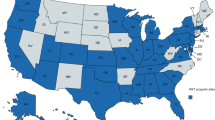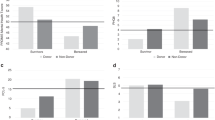Abstract
Psychosocial Assessment of Candidates for Transplant (PACT) is a tool originally developed to address psychosocial risks in solid organ transplant recipients and has the potential for application to hematopoietic cell transplantation (HCT) recipients. In a retrospective cohort study, we reviewed 404 adult allogeneic HCT cases from 2003 to 2014 to identify predictors of adverse psychosocial status as determined by PACT. Final PACT rating was poor/borderline (score 0–1) in 5%, acceptable (score 2) in 22%, good (score 3) in 44%, and excellent (score 4) in 29% recipients. In multivariable regression, higher PACT score was associated with White race (odds ratio [OR] 2.95, P < 0.001), having a related donor (OR 1.61, P = 0.015), and a higher quality of life score (OR 1.22/ 10-point increase in FACT-BMT total score, P < 0.001). PACT score correlated with all quality of life subscales. The final PACT score was associated with non-relapse mortality (HR 0.82/ 1-point increase, p = 0.03) in multivariable analysis that considered patient and disease factors, but not in models that also included transplant-related factors and performance status. PACT score was not associated with overall survival. PACT can be considered as part of a comprehensive psychosocial assessment for identifying patients who may require additional resources around allogeneic HCT.
This is a preview of subscription content, access via your institution
Access options
Subscribe to this journal
Receive 12 print issues and online access
$259.00 per year
only $21.58 per issue
Buy this article
- Purchase on Springer Link
- Instant access to full article PDF
Prices may be subject to local taxes which are calculated during checkout


Similar content being viewed by others
References
Baker KS, Davies SM, Majhail NS, Hassebroek A, Klein JP, Ballen KK, et al. Race and socioeconomic status influence outcomes of unrelated donor hematopoietic cell transplantation. Biol Blood Marrow Transplant. 2009;15:1543–54.
Fu S, Rybicki L, Abounader D, Andresen S, Bolwell BJ, Dean R, et al. Association of socioeconomic status with long-term outcomes in 1-year survivors of allogeneic hematopoietic cell transplantation. Bone Marrow Transplant. 2015;50:1326–30.
Hari PN, Majhail NS, Zhang MJ, Hassebroek A, Siddiqui F, Ballen K, et al. Race and outcomes of autologous hematopoietic cell transplantation for multiple myeloma. Biol Blood Marrow Transplant. 2010;16:395–402.
Hong S, Rybicki LA, Corrigan D, Schold JD, Majhail NS. Community risk score for evaluating health care disparities in hematopoietic cell transplantation. Biol Blood Marrow Transplant. 2018;24:877–9.
Majhail NS, Nayyar S, Santibanez ME, Murphy EA, Denzen EM. Racial disparities in hematopoietic cell transplantation in the United States. Bone Marrow Transplant. 2012;47:1385–90.
Majhail NS, Omondi NA, Denzen E, Murphy EA, Rizzo JD. Access to hematopoietic cell transplantation in the United States. Biol Blood Marrow Transplant. 2010;16:1070–5.
Sorror ML, Maris MB, Storb R, Baron F, Sandmaier BM, Maloney DG, et al. Hematopoietic cell transplantation (HCT)-specific comorbidity index: a new tool for risk assessment before allogeneic HCT. Blood. 2005;106:2912–9.
Pillay B, Lee SJ, Katona L, Burney S, Avery S. Psychosocial factors associated with quality of life in allogeneic stem cell transplant patients prior to transplant. Psychooncology. 2014;23:642–9.
Pillay B, Lee SJ, Katona L, De Bono S, Burney S, Avery S. A prospective study of the relationship between sense of coherence, depression, anxiety, and quality of life of haematopoietic stem cell transplant patients over time. Psychooncology. 2015;24:220–7.
Amonoo HL, Barclay ME, El-Jawahri A, Traeger LN, Lee SJ, Huffman JC. Positive psychological constructs and health outcomes in hematopoietic stem cell transplantation patients: a systematic review. Biol Blood Marrow Transplant. 2019;25:e5–16.
El-Jawahri A, Chen YB, Brazauskas R, He N, Lee SJ, Knight JM, et al. Impact of pre-transplant depression on outcomes of allogeneic and autologous hematopoietic stem cell transplantation. Cancer. 2017;123:1828–38.
Andrykowski MA. Psychosocial factors in bone marrow transplantation: a review and recommendations for research. Bone Marrow Transplant. 1994;13:357–75.
Hoodin F, Kalbfleisch KR. Factor analysis and validity of the Transplant Evaluation Rating Scale in a large bone marrow transplant sample. J Psychosom Res. 2003;54:465–73.
McQuellon RP, Russell GB, Rambo TD, Craven BL, Radford J, Perry JJ, et al. Quality of life and psychological distress of bone marrow transplant recipients: the ‘time trajectory’ to recovery over the first year. Bone Marrow Transplant. 1998;21:477–86.
Keogh F, O’Riordan J, McNamara C, Duggan C, McCann SR. Psychosocial adaptation of patients and families following bone marrow transplantation: a prospective, longitudinal study. Bone Marrow Transplant. 1998;22:905–11.
Ehrlich KB, Miller GE, Scheide T, Baveja S, Weiland R, Galvin J, et al. Pre-transplant emotional support is associated with longer survival after allogeneic hematopoietic stem cell transplantation. Bone Marrow Transplant 2016;51:1594–8.
U.S. Department of Health and Human Services. General considerations in assessment for transplant candidacy. 2015. https://optn.transplant.hrsa.gov/resources/ethics/general-considerations-in-assessment-for-transplant-candidacy/. Accessed 21 Dec 2018.
Kuntz K, Weinland SR, Butt Z. Psychosocial challenges in solid organ transplantation. J Clin Psychol Med Settings. 2015;22:122–35.
Lewandowski AN, Skillings JL. Who gets a lung transplant? Assessing the psychosocial decision-making process for transplant listing. Glob Cardiol Sci Pract. 2016;2016:e201626.
Olbrisch M, Levenson J, Hamer R. The PACT: a rting scale for the study of clinical decision making in psychosocial screening of orang transplant candidates. Clin Transplant. 1989;3:164–9.
Hitschfeld MJ, Schneekloth TD, Kennedy CC, Rummans TA, Niazi SK, Vasquez AR, et al. The psychosocial assessment of candidates for transplantation: a cohort study of its association with survival among lung transplant recipients. Psychosomatics. 2016;57:489–97.
Molassiotis A, Van Den Akker OB, Milligan DW, Goldman JM. Symptom distress, coping style and biological variables as predictors of survival after bone marrow transplantation. J Psychosom Res. 1997;42:275–85.
Murphy KC, Jenkins PL, Whittaker JA. Psychosocial morbidity and survival in adult bone marrow transplant recipients--a follow-up study. Bone Marrow Transplant. 1996;18:199–201.
Hoodin F, Kalbfleisch KR, Thornton J, Ratanatharathorn V. Psychosocial influences on 305 adults’ survival after bone marrow transplantation; depression, smoking, and behavioral self-regulation. J Psychosom Res. 2004;57:145–54.
Tschuschke V, Hertenstein B, Arnold R, Bunjes D, Denzinger R, Kaechele H. Associations between coping and survival time of adult leukemia patients receiving allogeneic bone marrow transplantation: results of a prospective study. J Psychosom Res. 2001;50:277–85.
Broers S, Hengeveld MW, Kaptein AA, Le Cessie S, van de Loo F, de Vries T. Are pretransplant psychological variables related to survival after bone marrow transplantation? a prospective study of 123 consecutive patients. J Psychosom Res. 1998;45:341–51.
Foster LW, McLellan L, Rybicki L, Dabney J, Visnosky M, Bolwell B. Utility of the psychosocial assessment of candidates for transplantation (PACT) scale in allogeneic BMT. Bone Marrow Transplant. 2009;44:375–80.
Foster LW, McLellan LJ, Rybicki LA, Dabney J, Welsh E, Bolwell BJ. Allogeneic BMT and patient eligibility based on psychosocial criteria: a survey of BMT professionals. Bone Marrow Transplant. 2006;37:223–8.
Hamilton BK, Rybicki L, Abounader D, Adekola K, Advani A, Aldoss I, et al. Allogeneic hematopoietic cell transplantation for adult T cell acute lymphoblastic leukemia. Biol Blood Marrow Transplant. 2017;23:1117–21.
Narkhede M, Rybicki L, Abounader D, Bolwell B, Dean R, Gerds AT, et al. The association of histologic grade with acute graft-versus-host disease response and outcomes. Am J Hematol. 2017;92:683–8.
Hamilton BK, Law AD, Rybicki L, Abounader D, Dabney J, Dean R, et al. Prognostic significance of pre-transplant quality of life in allogeneic hematopoietic cell transplantation recipients. Bone Marrow Transplant. 2015;50:1235–40.
American Society of Blood and Marrow Transplantation. ASBMT RFI 2015 - disease classifications corresponding to CIBMTR classification. 2015. https://www.asbmt.org/resource/resmgr/RFI/RFI_2015_-_CIBMTR_Disease_Cl.pdf. Accessed 15 Oct 2015.
Hart LG, Larson EH, Lishner DM. Rural definitions for health policy and research. Am J Public Health. 2005;95:1149–55.
Rural Health Research Center. Rural urban commuting area codes data. http://depts.washington.edu/uwruca/ruca-codes.php. Accessed 12 Oct 12, 2016.
US Census Bureau. American FactFinder. 2010. http://factfinder.census.gov/faces/nav/jsf/pages/index.html. Accessed 15 Oct 2015.
FACIT Measurement System. FACIT measurement system - questionnaires. 2016. http://www.facit.org/FACITOrg/Questionnaires. Accessed 12 Oct 2016.
Maldonado JR, Dubois HC, David EE, Sher Y, Lolak S, Dyal J, et al. The Stanford Integrated Psychosocial Assessment for Transplantation (SIPAT): a new tool for the psychosocial evaluation of pre-transplant candidates. Psychosomatics. 2012;53:123–32.
Presberg BA, Levenson JL, Olbrisch ME, Best AM. Rating scales for the psychosocial evaluation of organ transplant candidates. Comparison of the PACT and TERS with bone marrow transplant patients. Psychosomatics. 1995;36:458–61.
Funding
NM is partially supported by a grant from the National Cancer Institute (R01-CA215134).
Author information
Authors and Affiliations
Corresponding author
Ethics declarations
Conflict of interest
The authors declare that they have no conflict of interest.
Additional information
Publisher’s note: Springer Nature remains neutral with regard to jurisdictional claims in published maps and institutional affiliations.
Rights and permissions
About this article
Cite this article
Hong, S., Rybicki, L., Corrigan, D. et al. Psychosocial Assessment of Candidates for Transplant (PACT) as a tool for psychological and social evaluation of allogeneic hematopoietic cell transplantation recipients. Bone Marrow Transplant 54, 1443–1452 (2019). https://doi.org/10.1038/s41409-019-0455-y
Received:
Revised:
Accepted:
Published:
Issue Date:
DOI: https://doi.org/10.1038/s41409-019-0455-y
This article is cited by
-
Characterization of the stanford integrated psychosocial assessment for transplant for heart, liver, and kidney transplant candidates in Japan
BioPsychoSocial Medicine (2023)
-
Psychosocial assessment practices for hematopoietic stem cell transplantation: a national survey study
Bone Marrow Transplantation (2023)
-
Evaluating Socioeconomic, Racial, and Ethnic Disparities in Survival Among Patients Undergoing Allogeneic Hematopoietic Stem Cell Transplants
Journal of Racial and Ethnic Health Disparities (2023)
-
Survival protection of patients undergoing hematopoietic stem cell transplantation: grounded theory
Supportive Care in Cancer (2023)
-
Long-term survivors demonstrate superior quality of life after haploidentical stem cell transplantation to matched sibling donor transplantation
Journal of Translational Medicine (2022)



